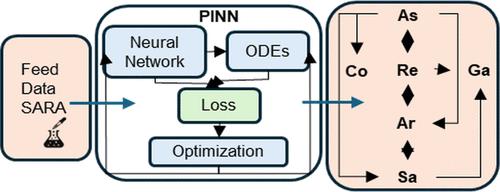基于NSGA II的物理信息神经网络和Levenberg-Marquardt方法的重油加氢裂化动力学建模
IF 3.9
3区 工程技术
Q2 ENGINEERING, CHEMICAL
引用次数: 0
摘要
准确模拟重油加氢裂化反应动力学对于优化反应器性能和改进产品分布预测至关重要。本研究提出了一种新的混合框架,将物理信息神经网络(PINN)与非支配排序遗传算法II (NSGA-II)和Levenberg-Marquardt (LM)优化方法相结合,以实现快速准确的动力学参数估计。与传统方法不同,本文提出的方法结合了全局和局部搜索:NSGA-II生成高质量的初始参数估计,而LM有效地对其进行改进,确保在300 epoch内收敛。这种混合框架利用神经网络来模拟随时间变化的行为,而基于龙格-库塔的求解器则加强反应动力学,从而在物理约束下实现鲁棒的动力学参数估计。先前在加氢裂化研究中提出的四种动力学模型作为物理约束实施,并使用PINN框架进行系统评估。其中,最详细的模型(此处称为模型4)是最全面和准确的,它捕获了所有主要的饱和烃、芳烃、树脂和沥青质(SARA)转化和副产品(气体和焦炭)的形成。在此基础上,剔除3个低灵敏度反应参数,提出了精细化的10参数动力学模型。简化模型保留了所有主要路径,并在四种温度(360-400°C)下表现出出色的预测精度,总误差(数据+质量分数的物理MSE)在训练、验证和测试中为10-3至10-2,R2在0.93至0.99之间。为了防止过拟合和提高泛化,采用了早期停止和20%退出策略。本文提出了一种将多目标进化算法与数值优化相结合的混合PINN框架在重油加氢裂化动力学建模中的新应用。通过将物理约束嵌入到学习过程中,该框架为估计反应参数和捕获加氢裂化过程的动态行为提供了一种可扩展、可解释和准确的方法。本文章由计算机程序翻译,如有差异,请以英文原文为准。

Physics-Informed Neural Network with NSGA II and Levenberg–Marquardt Method for Kinetic Modeling in Heavy Oil Hydrocracking
Accurately modeling reaction kinetics in heavy oil hydrocracking is essential for optimizing reactor performance and improving product distribution predictions. This study proposes a novel hybrid framework that integrates a physics-informed neural network (PINN) with nondominated sorting genetic algorithm II (NSGA-II) and Levenberg–Marquardt (LM) optimization method to achieve fast and accurate estimation of kinetic parameters. Unlike conventional approaches, the proposed method combines global and local search: NSGA-II generates high-quality initial parameter estimates, while LM efficiently refines them, ensuring convergence within 300 epochs. This hybrid framework leverages a neural network to model time-evolving behavior, while a Runge–Kutta–based solver enforces reaction kinetics, enabling robust kinetic parameter estimation under physical constraints. Four kinetic models previously proposed in hydrocracking research were implemented as physics constraints and systematically evaluated using the PINN framework. Among them, the most detailed, referred to here as model 4, emerged as the most comprehensive and accurate, capturing all major saturates, aromatics, resins, and asphaltenes (SARA) conversions and byproduct formation (gas and coke). Building upon this, a refined 10-parameter kinetic model was proposed by excluding three low-sensitivity reaction parameters. The simplified model preserved all dominant pathways and demonstrated excellent predictive accuracy across four temperatures (360–400 °C), total error (data + physics MSE on mass fractions) was on the order of 10–3 to 10–2 across training, validation, and testing, with R2 between 0.93 and 0.99. To prevent overfitting and improve generalization, early stopping and a 20% dropout strategy were employed. This study presents a novel application of a hybrid PINN framework that integrates a multiobjective evolutionary algorithm with numerical optimization for kinetic modeling in heavy oil hydrocracking. By embedding physical constraints into the learning process, the framework offers a scalable, interpretable, and accurate approach for estimating reaction parameters and capturing the dynamic behavior of the hydrocracking process.
求助全文
通过发布文献求助,成功后即可免费获取论文全文。
去求助
来源期刊

Industrial & Engineering Chemistry Research
工程技术-工程:化工
CiteScore
7.40
自引率
7.10%
发文量
1467
审稿时长
2.8 months
期刊介绍:
ndustrial & Engineering Chemistry, with variations in title and format, has been published since 1909 by the American Chemical Society. Industrial & Engineering Chemistry Research is a weekly publication that reports industrial and academic research in the broad fields of applied chemistry and chemical engineering with special focus on fundamentals, processes, and products.
 求助内容:
求助内容: 应助结果提醒方式:
应助结果提醒方式:


